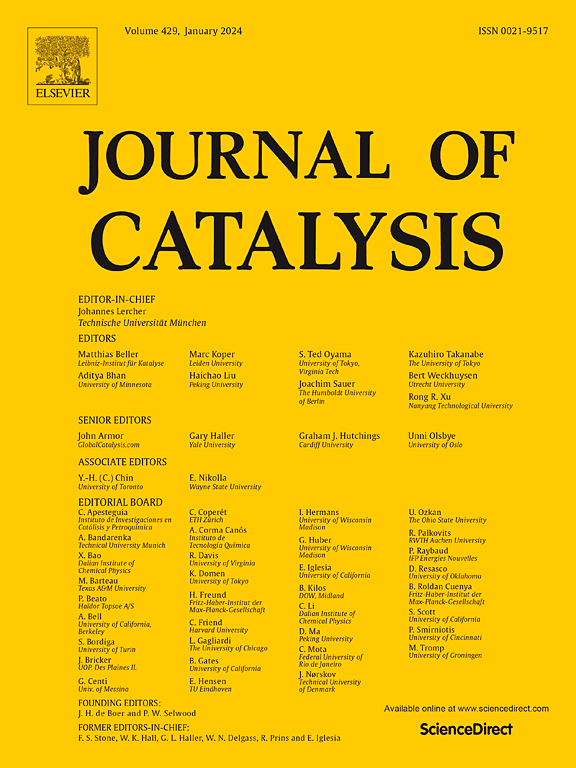Tailored and recyclable ppm levels of Pd nanoparticles for chemoselective hydrogenation of nitroarenes in water
IF 6.5
1区 化学
Q2 CHEMISTRY, PHYSICAL
引用次数: 0
Abstract
For the first time, a hitherto unreported green synthesis of anilines by the non-loading type ppm nanopalladium-catalyzed reduction of nitro compounds is described. The reaction and post-treatment purification processes can produce high-purity target products without the use of organic solvents. The catalytic turnover frequency was as high as 27062 h−1, which greater than that of the Pd/C catalyst under the same conditions. This even outperforms state-of-the-art Pd-, Pt-, and Ru-based catalysts for the nitrobenzene hydrogenation reported previously. Key to success was the design and utilization of the palladium nanoparticle with strong lipophilicity and highly stable, which permits the ppm palladium-catalyzed selective hydrogenation in water at room temperature without dispersant, providing a general preparation of functionalized anilines in good-to-high yields. The unprecedented high activity of the palladium nanoparticles is attributed to the support, which interacts strongly with the metal to maintain the oxidation–reduction states of the metals and accelerate the reaction. This work avoids the use of phase transfer reagents, as well as strong reductants, organic acids, and high-pressurized hydrogen gas as hydrogen sources, providing a promising concept for developing green catalytic systems. Benefitting from the heterogeneous manner, successful recycling in water of the catalysts was further achieved with high reaction efficiency maintained, and the total palladium leaching was less than 0.1 ppm after five cycles of the catalysts.


定制和可回收的ppm水平的钯纳米粒子的化学选择性氢化硝基芳烃在水中
第一次,迄今为止未报道的苯胺的绿色合成由非负载型ppm纳米钯催化硝基化合物的还原被描述。反应和后处理纯化过程可以在不使用有机溶剂的情况下生产高纯度的目标产品。催化周转频率高达27062 h−1,高于同等条件下Pd/C催化剂的周转频率。这甚至比以前报道的硝基苯加氢的最先进的Pd, Pt和ru基催化剂要好。成功的关键是设计和利用具有强亲脂性和高度稳定性的钯纳米颗粒,它允许在室温下在水中进行ppm钯催化的选择性加氢,而不需要分散剂,从而提供了高收率的功能化苯胺的一般制备。钯纳米颗粒具有前所未有的高活性,这归功于载体与金属的强烈相互作用,维持了金属的氧化还原状态,加速了反应。这项工作避免了相转移试剂的使用,以及强还原剂、有机酸和高压氢气作为氢源,为开发绿色催化体系提供了一个有前途的概念。得益于非均相方式,进一步实现了催化剂在水中的成功循环,保持了较高的反应效率,经过5次循环后钯的总浸出量小于0.1 ppm。
本文章由计算机程序翻译,如有差异,请以英文原文为准。
求助全文
约1分钟内获得全文
求助全文
来源期刊

Journal of Catalysis
工程技术-工程:化工
CiteScore
12.30
自引率
5.50%
发文量
447
审稿时长
31 days
期刊介绍:
The Journal of Catalysis publishes scholarly articles on both heterogeneous and homogeneous catalysis, covering a wide range of chemical transformations. These include various types of catalysis, such as those mediated by photons, plasmons, and electrons. The focus of the studies is to understand the relationship between catalytic function and the underlying chemical properties of surfaces and metal complexes.
The articles in the journal offer innovative concepts and explore the synthesis and kinetics of inorganic solids and homogeneous complexes. Furthermore, they discuss spectroscopic techniques for characterizing catalysts, investigate the interaction of probes and reacting species with catalysts, and employ theoretical methods.
The research presented in the journal should have direct relevance to the field of catalytic processes, addressing either fundamental aspects or applications of catalysis.
 求助内容:
求助内容: 应助结果提醒方式:
应助结果提醒方式:


